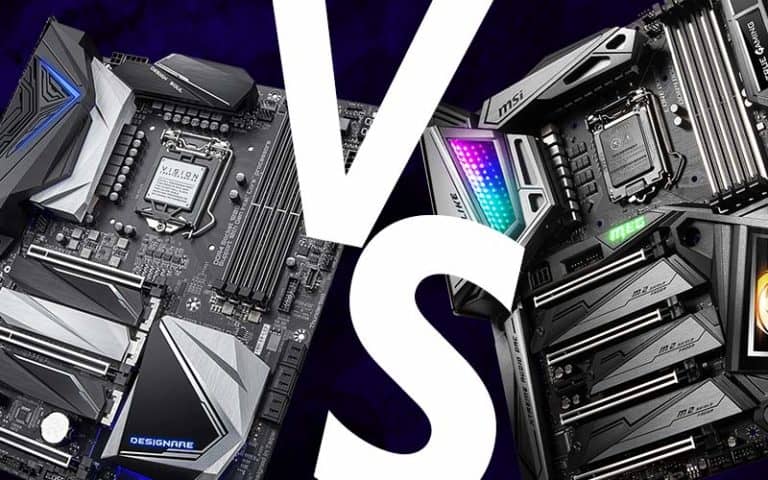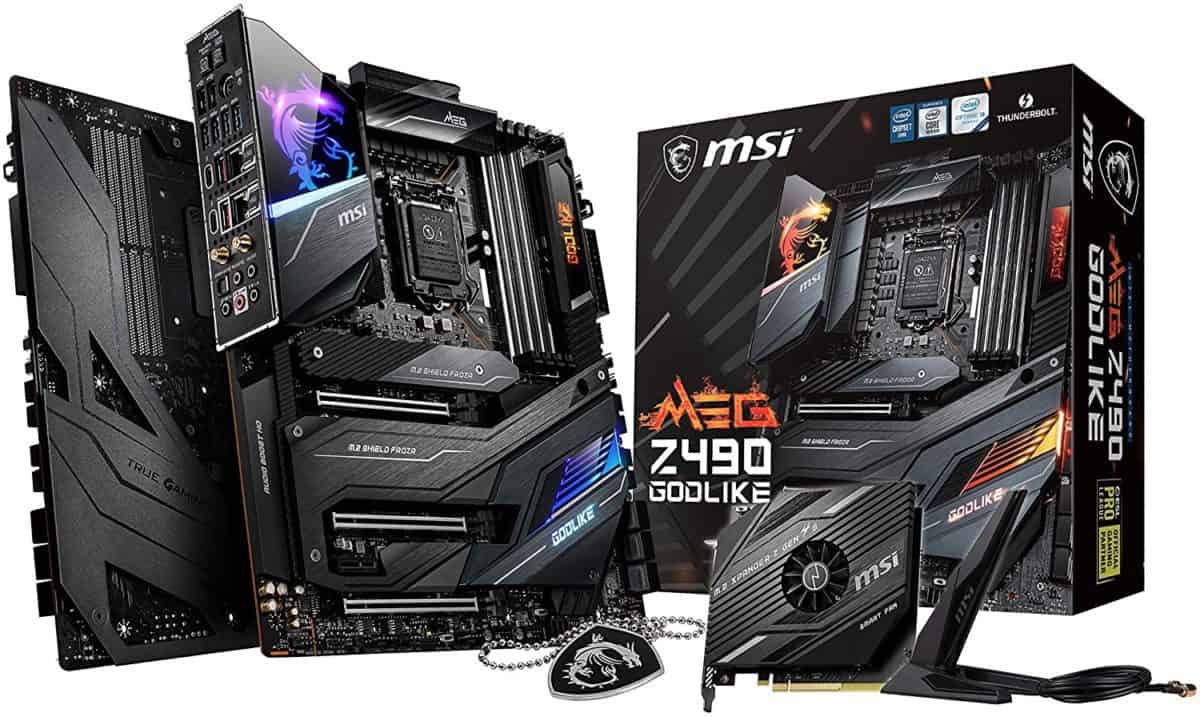Z490 Vs Z390
Once Intel had released their 10th Generation processors, it was inevitable that we would also see an updated motherboard chipset

Once Intel had released their 10th Generation processors, it was inevitable that we would also see an updated motherboard chipset. One designed to work with the 10th Generation CPUs specifically. Once this happened, surely the reign of the Z390 chipsets would be over.
As expected, Intel released the Z490, an updated motherboard chipset, that thrives in combination with 10th Generation CPUs, and is one of the most advanced chipsets on the market.
As with all new launches, we found many of you were curious about just how different the Z490 and Z390 are. Today, we’re going to answer that question for you.
In this article, we’re going to be discussing the key differences between the two chipsets and discover which is the better choice for your next PC build.
There are five key differences between the Z490 and the Z390 that we will be discussing today: LAN Speed, socket type, wireless network, interface, and memory frequency support.
By the time you have finished this article, you will know the answer to the question, which is better the Z490 or the Z390?
*We recommend that you have a CPU in mind before beginning this article, as your choice will affect which motherboard chipset will work in your build. The CPU sockets on the new Z490 chipset are only compatible with 10th generation Intel CPUs.
So you need to know what CPU you would like to use in your build before you pick a motherboard. Need help? Check out our range of articles on that topic here.
Chipset Reviews
Note – You will notice if you spend any time researching chipsets on Intel’s website that they actually refer to their chipsets as Platform Controller Hubs (PCHs).
Other brands like AMD choose to stick with chipsets. They are all essentially the same thing and fulfill the same role within your motherboard.
The Specs
Both of these chipsets are bridging chipsets (meaning that they contain both the southbridge and northbridge chipsets of old in one place).
Below are the key stats for Intel’s 3790 and 3490 chipsets:

MSI MEG Z390 GODLIKE

Intended Build
Intel High End Builds
Form Factor
E-ATX
Overclocking Support
Yes
Socket
LGA1151
Chipset
Z390
Aesthetically an extremely attractive looking board
Triple Turbo M.2 with M.2 Shield Frozr
Supports up to 4600Mhz RAM with DD4 Boost
Miniature onabord OLED display
Onboard switches to quickly change BIOS profiles
Very expensive
Large form factor

MSI MEG Z490 GODLIKE

Intended Build
Intel – High-end
Form Factor
E-ATX
Overclocking Support
Yes
Socket
LGA 1200
Chipset
Z490
Very aesthetically pleasing motherboard
Built-in heat sink Fan
Comes with a capture card
Great for overclocking
Very expensive
The Features
Z490 vs Z390 – PCI Express
We wanted to start this section with something interesting so let’s talk about PCI.
Some of the current and future Z490 motherboards will be capable of running PCI 4.0. This is something the Z390 sadly can’t dream of doing. If you’re thinking that you may want to upgrade your build in the future picking up a Z490 motherboard now is a great idea. Think of all that increased processing speed!
PCI Express has been proven to drastically increase graphics card and hard disk performances.
The current range of Intel processors (10th generation)cannot currently support PCI express 4. So you will have to wait until they release the 11th generation – the good news is that Z490 motherboards will be compatible with Intel 11th generation CPUs.
Z490 vs Z390 – sockets
Let’s move on to something less glamorous, sockets.
We briefly mentioned above, but it bears repeating – the LGA 1200 socket that comes with the Z490 will not be backward compatible with legacy CPU models.
The Z490 comes with the LGA 1200 which is compatible with 10th generation CPUs and will work with 11th generation ones as well. The Z390 on the other hand comes fitted with LGA 1151 sockets. These are compatible with 8th and 9th generation Intel CPUs.
This is important to bear in mind for the following three reasons:
- You want to use an Intel Comet Lake Processor
- You have a 10th generation CPU from Intel
- If you think you may upgrade to a 10th or 11th generation CPU in the future.
As always with these hardware brands, it goes without saying that an AMD CPU with not be compatible with an Intel motherboard and vice versa. For this part of the build, you’ll have to commit to one brand.
Z490 vs Z390 – Max Memory Frequency
This is an area where we commonly see an improvement from generation to generation. The jump from Z390 to Z490 is no different.
There is a slight difference in the maximum memory frequency that these two chipsets can support. The Z490 providing an extra 263MHz of memory frequency. It reached an impressive DDR4 2933, compared to the Z390’s DDR4 2666.
Unfortunately, Intel’s systems are not sensitive enough for this extra memory to make a noticeable difference in your gameplay.
Both chipsets are, however, designed with overclocking in mind. You will notice that the Z490 copes better with this method.
Z490 vs Z390 – LAN speeds
This category holds another significant victory for the Z490. The max LAN speed of the Z390 is 1.7 Gbps. The Z490 can now offer 2.5 Gbps. That is an impressive jump between generations.
However, LAN speed may only really be relevant in that alternative universe where we all have strong internet connections. The average internet connection in the US can’t support LAN speed above 0.9 Gbps.
If you’re one of the blessed few who could enjoy a 2.5 Gbps speed then it’s really worth considering the Z490.
Z490 vs Z390 – Intel CNVi Wireless Technology
Intel CNVi Wireless Technology is a new feature built into the Z490. This is where the chipset gains its ability to run PCI express 4.0 (when the CPUs eventually catch up). It also means that the Z490 comes with built-in Wi-Fi 6.
Wifi 6 has power conserving features that are perfect for gaming laptops. They have also been fine-tuned to produce better performances and transfer speeds in congested areas. And they run like a dream in quiet, home settings.
As we mentioned above, current home networks aren’t powerful enough to see much benefit from the Wifi 6 setup. However, in the next couple of years, we expect to see huge improvements in these areas. As this happens, the Z490 will be allowed to reach its full potential, and it will be something very impressive.
This is not an option that is available on the Z390. It can run Wi-Fi at speeds of 1.7 Mbps, however, the Z490 runs at an enviable 2.4 Mbps.
Pricing and Availability
As you will know when it comes to motherboards, not all are made equal, and they certainly aren’t equal in price.
Best Z390 options:
Best Z490 options:
Prices for a motherboard with Z390 range from under $200 to well above $400. We have seen Z490 motherboards from as low as just under $300 to over $600. This range includes a plethora of brands. The consistent difference across all of these companies is that the Z490 costs roughly $100 more than its predecessor.
Is it worth the extra money? Let’s consider the factors we’ve mentioned today.
If you’re looking to install an Intel generation 10 (or generation 11 when they come out) then you don’t really have a choice but to install a Z490. They were designed to run those more advanced CPUs. So much so you can’t actually plug anything else into them.
If you’re looking to use PCI express 4.0 then you should be picking the Z490. Although there is currently no way to run PCI express 4.0 on an Intel CPU when generation 11 comes out things will change. The Z390 will be incompatible with generation 11.
Setting the CPUs aside for a second, the Z490 just steals a win when it comes to overclocking and max memory frequency. As we mentioned earlier, the way Intel systems run, this extra 273 MHz of memory doesn’t make a noticeable difference to user experience or gameplay.
If LAN is a big part of your gaming life then you might want to consider moving to the Z490 as it offers 2.5 Gbps compared to the Z390’s 1.7 Gbps.
When network bandwidth is able to support this LAN speed (or if you’re lucky enough to have a good connection already) then this higher LAN speed will make a huge difference to your gaming experience.
On the note of network bandwidth, whilst we are waiting for the networks to catch up with our PCs, let’s talk about Wifi 6. Not available on the Z390, Wifi 6 can offer speeds of up to 2.4 Mbps. That’s a 30% improvement on the previous generation. Wifi 6 is also what gives the Z490 the ability to run PCI express 4.0.
When our network bandwidth is able to run these speeds the Z490 will truly be a force to be reckoned with.
The short of it all is that Intel has made the Z390 a lot less valuable by making it incompatible with generation 10 CPUs. If you want to keep up with the latest, most powerful CPUs then you have no choice but to buy the latest motherboards. Is this necessary technological advancement or clever marketing? Only time will tell.
Availability
We love writing this section about products from or including Intel parts because there’s never any fuss around their launches.
On the release of the Z490, there were many motherboards available for purchase including this chipset. Now, there are even more. You will have no trouble getting your mitts on one of these.
For more information on getting your hands on a Z490 motherboard, check out this article.
Final Thoughts
Your choice of CPU will heavily affect your choice of motherboard. If you have gone for an older generation CPU (8th or 9th generations) then you have to pick the Z390. Not that this is a bad thing. This is still an advanced motherboard that performs well in all the major categories.
However, if you want the top of the range, 10th Generation CPU from Intel then there is no choice, the Z490 is what you need.
You’ll find that the Z390 can’t run a 10th generation CPU, that didn’t exist when it was launched so theoretically they’ll struggle with the power level. But on a more practical level, you can’t plug them into a newer CPU.
As so much of the responsibility for overclocking rests on the chipset, it is important to get one that is powerful enough for your needs. If you don’t get this right, you’ll see a real impact on your gaming experience.
The good news is if you get a Z490 you’ll be able to run any 10th Generation CPU, and it will most likely be able to cope with 11th Generation models once they are released (for more information on this, check out this article).
So who wins the race?
Well, they both win their own races. These two can’t directly compete because they can’t run the same CPUs. Both have great numbers in every key area. The Z490 does better than the Z390 in all of them. However, their value to your build will entirely come down to what CPU you intend to use.

